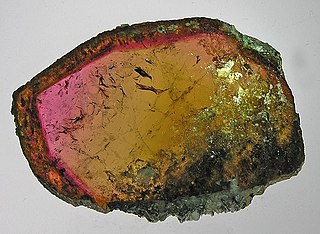
Tourmaline is a crystalline silicate mineral group in which boron is compounded with elements such as aluminium, iron, magnesium, sodium, lithium, or potassium. This gemstone comes in a wide variety of colors.

Allanite (also called orthite) is a sorosilicate group of minerals within the broader epidote group that contain a significant amount of rare-earth elements. The mineral occurs mainly in metamorphosed clay-rich sediments and felsic igneous rocks. It has the general formula A2M3Si3O12[OH], where the A sites can contain large cations such as Ca2+, Sr2+, and rare-earth elements, and the M sites admit Al3+, Fe3+, Mn3+, Fe2+, or Mg2+ among others. However, a large amount of additional elements, including Th, U, Be, Zr, P, Ba, Cr and others may be present in the mineral. The International Mineralogical Association lists four minerals in the allanite group, each recognized as a unique mineral: allanite-(Ce), allanite-(La), allanite-(Nd), and allanite-(Y), depending on the dominant rare earth present: cerium, lanthanum, neodymium or yttrium.

Elbaite, a sodium, lithium, aluminium boro-silicate, with the chemical composition Na(Li1.5Al1.5)Al6Si6O18(BO3)3(OH)4, is a mineral species belonging to the six-member ring cyclosilicate tourmaline group.

Digenite is a copper sulfide mineral with formula: Cu9S5. Digenite is a black to dark blue opaque mineral that crystallizes with a trigonal - hexagonal scalenohedral structure. In habit it is usually massive, but does often show pseudo-cubic forms. It has poor to indistinct cleavage and a brittle fracture. It has a Mohs hardness of 2.5 to 3 and a specific gravity of 5.6. It is found in copper sulfide deposits of both primary and supergene occurrences. It is typically associated with and often intergrown with chalcocite, covellite, djurleite, bornite, chalcopyrite and pyrite. The type locality is Sangerhausen, Thuringia, Germany, in copper slate deposits.
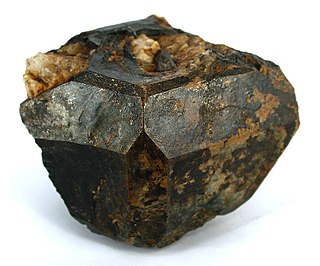
Microlite was once known as a pale-yellow, reddish-brown, or black isometric mineral composed of sodium calcium tantalum oxide with a small amount of fluorine. Its chemical formula is(Na,Ca)2Ta2O6(O,OH,F). Today it is a name of a group of oxide minerals of a similar stoichiometry having tantalum prevailing over titanium and niobium. The microlite group belongs to a large pyrochlore supergroup that occurs in pegmatites and constitutes an ore of tantalum. It has a Mohs hardness of 5.5 and a variable specific gravity of 4.2 to 6.4. It occurs as disseminated microscopic subtranslucent to opaque octahedral crystals with a refractive index of 2.0 to 2.2. Microlite is also called djalmaite, but both names are now obsolete.

Aheylite is a rare phosphate mineral with formula (Fe2+Zn)Al6[(OH)4|(PO4)2]2·4(H2O). It occurs as pale blue to pale green triclinic crystal masses. Aheylite was made the newest member of the turquoise group in 1984 by International Mineralogical Association Commission on New Minerals and Mineral Names.

Fluor-buergerite, originally named buergerite, is a mineral species belonging to the tourmaline group. It was first described for an occurrence in rhyolitic cavities near Mexquitic, San Luis Potosi, Mexico. It was approved as a mineral in 1966 by the IMA and named in honor of Martin J. Buerger (1903–1986), professor of mineralogy at the Massachusetts Institute of Technology. It has also been reported from Minas Gerais, Brazil, and the Central Bohemia Region of the Czech Republic.

Cabalzarite is a rare arsenate mineral with the chemical formula Ca(Mg,Al,Fe3+
)
2[AsO
4]
2•2(H
2O,OH). It is a member of the tsumcorite group. It crystallizes in the monoclinic system and typically occurs as clusters of crystals or granular aggregates.
Cleusonite is a member of the crichtonite group of minerals with the chemical formula (Pb,Sr)(U4+
,U6+
)(Fe2+
,Zn)
2(Ti,Fe2+
,Fe3+
)
18(O,OH)
38. This group of minerals contains approximately thirteen complex metal titanates. The structures of minerals of this group is complicated by frequent fine-scale twinning and metamictization due to radioactive elements. The crichtonite group consists of members of related mineral species of the type A{BC2D6E12}O38 which are characterized by their predominant cations (as seen in crichtonite (Sr), senaite (Pb), davidite (REE + U), landauite (Na), loveringite (Ca), lindsleyite (Ba), and mathiasite (K).

Hureaulite is a manganese phosphate with the formula Mn2+5(PO3OH)2(PO4)2·4H2O. It was discovered in 1825 and named in 1826 for the type locality, Les Hureaux, Saint-Sylvestre, Haute-Vienne, Limousin, France. It is sometimes written as huréaulite, but the IMA does not recommend this for English language text.

Zemannite is a very rare oxide mineral with the chemical formula Mg0.5ZnFe3+[TeO3]3·4.5H2O. It crystallizes in the hexagonal crystal system and forms small prismatic brown crystals. Because of the rarity and small crystal size, zemannite has no applications and serves as a collector's item.
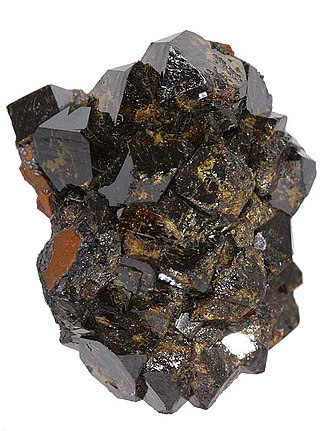
Beudandite is a secondary mineral occurring in the oxidized zones of polymetallic deposits. It is a lead, iron, arsenate, sulfate with endmember formula: PbFe3(OH)6SO4AsO4.
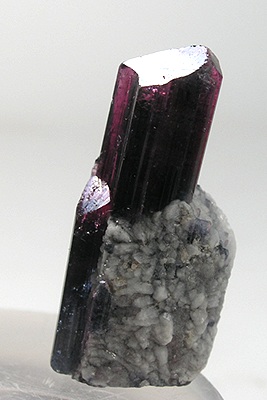
Fluor-liddicoatite is a rare member of the tourmaline group of minerals, elbaite subgroup, and the theoretical calcium endmember of the elbaite-fluor-liddicoatite series; the pure end-member has not yet been found in nature. Fluor-liddicoatite is indistinguishable from elbaite by X-ray diffraction techniques. It forms a series with elbaite and probably also with olenite. Liddiocoatite is currently a non-approved mineral name, but Aurisicchio et al. (1999) and Breaks et al. (2008) found OH-dominant species. Formulae are

Walfordite is a very rare tellurite mineral that was discovered in Chile in 1999. The mineral is described as orange with orange-yellow streak, and is determined to have a chemical formula of Fe3+,Te6+Te4+3O8 with minor titanium and magnesium substitution resulting in an approximate empirical formula of (Fe3+,Te6+,Ti4+,Mg)(Te4+)3O8.

Fluor-uvite is a tourmaline mineral with the chemical formula CaMg3(Al5Mg)(Si6O18)(BO3)3(OH)3F. It is a rare mineral that is found in calcium rich contact metamorphic rocks with increased amounts of boron. Uvite is trigonal hexagonal, which means that it has three equal length axes at 120 degrees, all perpendicular to its fourth axis which has a different length. Uvite is part of the space group 3m. Uvite's hardness has been measured to be 7.5 on the Mohs hardness scale. The color of uvite widely varies, depending on the sample, but is mostly deep green or brown. In regard to uvite's optical properties, it is uniaxial (-) and anisotropic, meaning that the velocity of light in the mineral depends on the path that it takes. In plane polarized light, uvite is colorless to pale yellow and shows weak pleochroism.
Feklichevite is a rare mineral of the eudialyte group with the formula Na11Ca9(Fe3+,Fe2+)2Zr3NbSi(Si3O9)2(Si9O27)2. The original formula was extended to show the presence of cyclic silicate groups and presence of silicon at the M4 site, according to the nomenclature of eudialyte group. When compared to other minerals of the group, feklichevite characterizes in the presence of ferric iron (thus similar to ikranite, mogovidite and fengchengite) and dominance of calcium at the N4 site. Calcium is ordered in the structure and is also present at the M1 site. Other iron-bearing minerals of the group are eudialyte, ferrokentbrooksite, georgbarsanovite, khomyakovite, labyrinthite, oneillite and rastsvetaevite, but they rather contain ferrous iron Feklichevite name honors Russian mineralogist and crystallographer, V. G. Feklichev.
Arakiite (IMA symbol: Ark) is a rare mineral with the formula (Zn,Mn2+)(Mn2+,Mg)12(Fe3+,Al)2(As3+O3)(As5+O4)2(OH)23. It is both arsenate and arsenite mineral, a combination that is rare in the world of minerals. Arakiite is stoichiometrically similar to hematolite. It is one of many rare minerals coming from the famous Långban manganese skarn deposit in Sweden. Other minerals bearing both arsenite and zinc include kraisslite and mcgovernite.
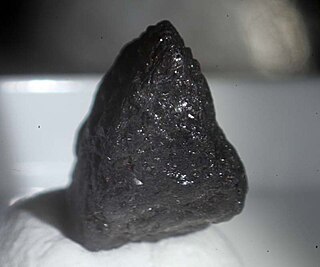
Lucchesiite is a new member of tourmaline-group of minerals. Lucchesiite has the formula CaFe3Al6(Si6O18)(BO3)3(OH)3O. It is the calcium and oxygen-analogue of schorl. It has two co-type localizations, one in Czech Republic and the other in Sri Lanka. As the other members of the tourmaline group, it is trigonal.
Filipstadite is a very rare mineral of the spinel group, with the formula (Mn,Mg)(Sb5+0.5Fe3+0.5)O4. It is isometric, although it was previously though to be orthorhombic. When compared to a typical spinel, both the octahedral and tetrahedral sites are split due to cation ordering. Filipstadite is chemically close to melanostibite. The mineral comes from Långban, Sweden, a manganese skarn deposit famous for many rare minerals.
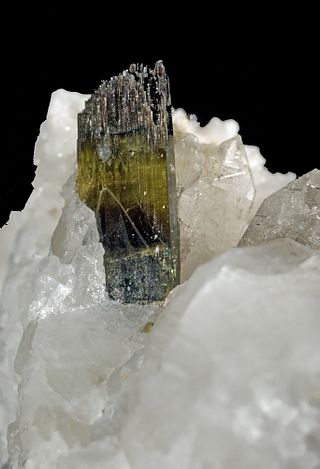
Foitite is a mineral in the tourmaline group, it is a vacancy-dominant member of the group. Foitite is in the 'vacancy' group, due to the absence of atoms in the X site.
















